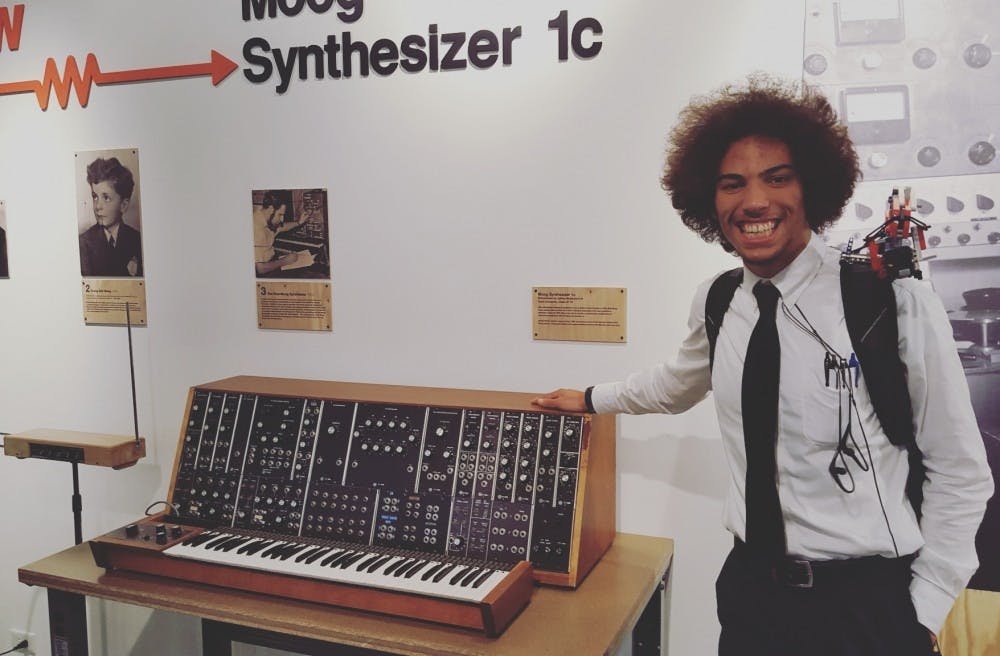Sophomore Jeffrey Wubbenhorst recently made waves at Moogfest—a music, art and technology festival held in Durham this year from May 19 to 22—with his restored music synthesizer, which he developed as part of an independent study and affectionately named "Misty" or "Mystery Moog." The Chronicle's Claire Ballentine sat down with Wubbenhorst to discuss his project.
The Chronicle: How did you first get the idea to restore a synthesizer?
Jeffrey Wubbenhorst: Honestly, the short answer is something along the lines of “because I had to.” Playing a Moog modular synthesizer was a dream of mine for literally years, and the fact that the synthesizer didn’t actually work was in my mind just a small obstacle towards that glorious end.
TC: What was the process of restoring it like?
JW: The device is an older analog system with some highly valued quirks, which had to be respected in order to preserve the integrity of the instrument. In this particular case, the restoration process involved comparing expected and actual behaviors, and working to reconcile the two on a technical level. For most modules, this meant testing and replacing individual components that had failed in the unit’s 48-year history. On a more menial level, this involved a lot of poking about with a multimeter [an instrument designed to measure electric current, voltage and resistance] at late hours of the night.
TC: Tell me a little about the independent study involved with it.
JW: The independent study part of this project was also something that just sort of had to happen in order to make everything else work. As one might expect, Duke doesn’t currently offer courses in analog synthesis, and didn’t really have an existing framework for the project. Since the project was to involve musical composition, repairs and upfitting, there was ample material for an independent study course.
TC: How did the finished synthesizer end up at Moogfest?
JW: Part of my project’s objectives included producing a musical composition using only sounds from the synthesizer, which was a bit of a challenge. I reached out to [Moog Music, a company that manufactures electronic musical instruments] for some technical expertise in repairing the instrument, and asked them to lend some equipment to help complete the project. The folks at Moog have been very kind in helping me, and when they offered to exhibit the instrument at Moogfest as well as give me free tickets, I could do little else but say yes.
The process was actually quite straightforward. I discussed a course with Professor Scott Lindroth, my advisor for the project, put together a rubric and course description and submitted a few more forms. In my experience, the administration here is very open to helping students study a topic that might not exist within the existing course offerings.
TC: What was your experience at Moogfest like?
JW: While the word “surreal” doesn’t quite apply here, there were times when it came pretty close. I’ve been interested in synthesizers for some time now, and I’d dreamed of going to Moogfest for a number of years. To see Misty—as I’ve named it for “Mystery Moog”—on display made me very, very happy. It was a huge milestone to see what I’d been working on all semester come together at the world’s largest celebration of analog synthesis.
TC: How was the synthesizer received by visitors?
JW: People seemed quite interested in Misty, which actually surprised me. I think—given the embarrassing number of hours I’d spent with the device—that I had forgotten how truly unique the instrument is, especially for its age. Overall, Misty was very well received, and it was a great honor to have the device on public display with so many other wonderful synths.
TC: What was the most challenging aspect of the project?
JW: On a technical level, Misty was in better shape than I had expected given it’s age. For a 48-year-old instrument—very old on the timeframe of synthesis—it was remarkably functional. Repairing things was a bit tedious, but Moog’s original documentation and advice from today’s engineers made the process much easier than it could have been.
TC: What did you find most rewarding about the project?
JW: I think, in terms of sheer excitement, the day the oscillator section [which is the part of the instrument that makes noise] started working was one of the best moments in the project. The Moog oscillators have a very powerful sound, and I had been working on the instrument for a long time without an audible reward for my efforts.
Honestly, though, I think the most rewarding part of the project is yet to come. The goal of the restoration process has been to play the instrument, and that is going to be a wonderful journey.
Get The Chronicle straight to your inbox
Signup for our weekly newsletter. Cancel at any time.

